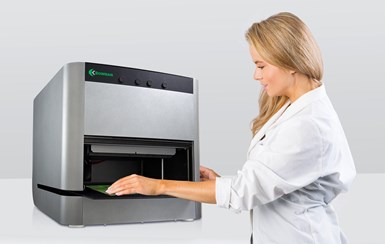Trends in Plating on Plastic
As plastics have become more ubiquitous, the demand for metal plating of plastics has increased.

Three of the eight benchtop XRF plating measurement instruments manufactured by Bowman are ideally suited to plating on plastic parts. The P Series XRF shown has a programmable X-Y stage and the ability to create programs to automatically measure multiple sample locations with one click. Source | Bowman
Q: As an increasing number of plastic and composite parts are finding their way into various applications, what are the latest advances in plating on plastics?
A: As plastics have become more ubiquitous, the demand for plating metals onto plastics has markedly increased. With requirements ranging from purely aesthetic to demands for high-performance plastics in electronic applications, the automotive, electrical, plumbing and medical device industries are embracing metalized plastic.
Metal coatings on plastics can protect against corrosion and chemical attack, impart electrical conductivity and thermal shielding, increase strength and durability, and improve aesthetics. Additionally, the prospect of replacing traditional materials with lower-cost (or lower weight) plastics that have been imbued with the properties of metal plating has further enhanced demand.
While traditional electroplating processes have been used for years to deposit metal onto plastic, specialized techniques with unique attributes are gaining acceptance. Vapor deposition can create metal thin films down to the nanometer scale, a capability useful for applications such as creating EMI/RFI (electromagnetic interference and radio frequency interference) shielding layers for plastic-enclosed electronic components and lining food packaging to extend shelf life. In-mold processes can combine the metal plating and plastic molding into one step, seamlessly integrating the two.
Today’s plating applications, particularly those involving electronics and thin films, are required to meet specifications — particularly thickness specifications — that are tighter than in the past. X-Ray Fluorescence (XRF) is the most reliable method for precisely measuring both thickness and composition of metal layers on plastic substrates.
XRF measures plating deposits by bombarding the sample with high-energy X-rays, which cause the atoms within the coating to emit characteristic fluorescent X-rays. These emitted X-rays are then analyzed by a detector to determine the composition and thickness of the coating. XRF is non-destructive, and has sample preparation time markedly shorter than alternative methods.
The detector is the most important component of every XRF instrument. Original XRF devices used proportional (“prop”) counters, which were adequate at the time, but have largely been replaced by silicon drift detectors (SDDs) — where precision is paramount or testing volumes are high.
XRF systems equipped with SDDs quickly measure even multi-layer thin films. SDDs are widely favored partly because their energy resolutions are 5 or more times higher, and they can analyze light elements (down to 13 Al). For thin coating applications, SDDs’ higher resolution assures stability and accuracy not available elsewhere. Notably, the layout used in Bowman XRFs allows close-coupling of the X-ray tube and detector, a feature that produces more than three times higher counts. This results in lower detection limits and enhanced precision.
An equally important factor favoring SDDs is testing speed. Proportional counter devices require a secondary filter to identify more than one element; multiple filters are generally needed to generate a full compositional analysis. Where analysis speed is a factor, and in all high-production environments, SDD-equipped XRFs have a defining advantage in measurement speed, with the ability to quantify up to 4 deposited layers — and up to 10 elements in each layer — simultaneously, and in seconds. Today, the entire product lines of the most advanced XRF manufacturers, including Bowman, use SDDs exclusively.
Plating on Plastics is a winning strategy for OEMs and the shops that serve them. Electrification of the auto sector works in its favor, as do sustainability initiatives that promote lighter weight materials. Advancements in plating chemistry also favor POP, with recent developments including a chromic acid alternative that creates adhesion using molecular surface alteration, rather than etching, to create adhesion between metal and plastic.
Small wonder that POP has an annual CAGR of 7.9% from now through 2032.
Related Content
Products Finishing Reveals 2023 Qualifying Top Shops
Each year PF conducts its Top Shops Benchmarking Survey, offering shops a tool to better understand their overall performance in the industry. The program also recognizes shops that meet a set of criteria to qualify as Top Shops.
Read MoreTroubleshooting Alkaline Zinc
One of the most common problems that can arise when plating with alkaline zinc is an imbalance of brightener in the solution. In this helpful Ask the Expert article, Chad Murphy of Columbia Chemical discusses how different zinc metal concentrations and brightener concentrations can impact efficiency.
Read MoreA Chromium Plating Overview
An overview of decorative and hard chromium electroplating processes.
Read MoreAn Overview of Electroless Nickel Plating
By definition, electroless plating is metal deposition by a controlled chemical reaction.
Read MoreRead Next
Education Bringing Cleaning to Machining
Debuting new speakers and cleaning technology content during this half-day workshop co-located with IMTS 2024.
Read MoreEpisode 45: An Interview with Chandler Mancuso, MacDermid Envio Solutions
Chandler Mancuso, technical director with MacDermid Envio discusses updating your wastewater treatment system and implementing materials recycling solutions to increase efficiencies, control costs and reduce environmental impact.
Read MoreA ‘Clean’ Agenda Offers Unique Presentations in Chicago
The 2024 Parts Cleaning Conference, co-located with the International Manufacturing Technology Show, includes presentations by several speakers who are new to the conference and topics that have not been covered in past editions of this event.
Read More





















